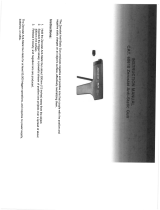
These amplifiers are designed to work within a
10
to 16.8 volt DC range. Before any wires
are connected, the vehicles electrical system should be checked for correct voltage supply
with the help
of
a voltmeter.
First, check the voltage at the battery with the ignition in the OFF position. The voltmeter
should read no less than 12V.
If
your vehicles electrical system is not up to these
specifications, we recommend having it checked by an auto electrician before any further
installation. Once the vehicle is checked, make certain the correct cable size is used. We
recommend using as large a gauge cable
as
possible, use the Power Cable Selection Chart
to calculate the correct power wire size for your application.
Power
This amplifier should be wired directly to the vehicle battery using the appropriate size
cable. Start at the vehicle battery and run the power cable through to the amplifier. Avoid
running the power cable over engine components and near heater cores. The use
of
an inline
fuse or circuit breaker is a must; this will prevent the risk
of
a potential fire caused by a
short in your power cable. Connect the fuse holder or circuit breaker
as
close to the battery
positive(+) terminal as possible (no farther then 18" from the battery). This fuse or circuit
breaker should be no greater then the sum
of
the fuses found on the chassis
of
your
amplifier (also see specifications chart). You may now connect the cable to the battery, but
remember to leave the fuse out or circuit breaker
"off'
until all other cable connections are
made.
Ground
When grounding your amplifier, locate a metal area close
to
the amplifier that is good
source
of
ground (preferably the floor pan). Once again, investigate the area you wish to
use for electrical wires, vacuum lines, and brake or fuel lines. Use either a wire brush or
sandpaper to eliminate unwanted paint for better contact
of
the ground. Secure the ground
cable to the body using a bolt, star washer and nut. Spread silicon over the screw and bare
metal to prevent rust and possible water leaks.
Now it's time to connect the power and ground cables to the amplifier. Cut both cables
to length. Strip
off
1/2
-inch
(12mm)
of
the insulation so that the bare wire fits all the way
in the terminal block on the side panel
of
the amplifier, seating it firmly so no bare wire is
exposed. Use a Philips (cross) type screwdriver to loosen the +BATT and the GND
connections on the amplifier. Insert the ground first, and then
the+
12V and please make
sure that you place them into the correctly marked terminals. Then tighten the screws down
securely.
12




















